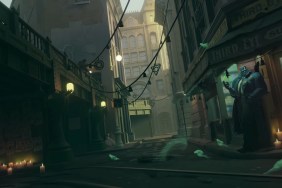No goos were harmed during the writing of this review. We think.
World of Goo starts off with what seems to be a simple task – get the little goo balls to a pipe. With that basic premise, it builds progressively challenging concepts that expand into a very worthwhile game, both in difficulty and innovation.
[image1]Indie developer 2D Boy started this game as a pet project that ended up being presented as one of the flagship titles for the Wii’s Wiiware service. Going against the mold of games being simple due to size limitations, World of Goo challenges the player to find creative solutions to problems, while showing that something simple doesn’t have to stop being innovative.
The concept of transporting and constructing with little goo balls is plastered into four unique game worlds, where the seemingly easy object of saving a certain quantity of goo gets worked on by the variety of situations and circumstances (as well as the goo balls themselves). By connecting goo to goo, support structures can be built in a variety of forms, like a bridge to cross a canyon. In other cases, the environment isn’t as forgiving, presenting obstacles that can not only hamper the goos’ progress, but also completely destroy any chances of success.
At the beginning, you’re likely to only stumble upon the game’s ‘basic’ goo units – the black goos – which introduce all the standards for World of Goo‘s mechanics. Every different type of goo ball has its own limitations and advantages – some disconnect rather easily but can withstand harsher surfaces; others are lighter but extremely sensitive to outside forces. Building is totally dependant on using the tools and goos at hand in a particular level. A certain number of goos have to be saved in every stage, with bonus points awarded for extra "souls" saved. These bonus goos can then be used in a special sandbox level, separate from the main game, called Goo Corporation, where the objective is to simply build whatever you want. The taller your structure gets, the closer you’ll get to a special "surprise" promised by writings on the factory’s walls.
[image2]Nowadays, a game’s presentation can often propel it onto the spotlights, regardless of redeeming qualities outside of it. Luckily, World of Goo sports a quirky yet simple visual style, and incredible replayability to boot. Taking a cue from games like LocoRoco and Katamari Damacy, the goo balls are very cute and simple, nothing more than little inky balls with eyes (sometimes not even that). Yet they retain enough personality to make you sad for each one that meets its fate due to your strategical mistakes.
The worlds are also very simple on the eyes, in a very 2D colorbook sort of way. In the rare story cutscenes – if they can be called that, since there’s hardly a story at all – stick figure, Tim Burton-esque people take the stage. Adding to this sense of awe and fantasy, a dramatic soundtrack that makes the tongue-in-cheek peril in which the goos are thrown that much more intense.
Regardless of what control peripheral in whatever version of World of Goo you pick up, controlling the action is very intuitive. As a structure is built, the goos start slinking around, which then can be dragged to create extra paths and trails of goo in 60 degree angles. Many of the physics involved in construction and engineering are taken into consideration, such as balance, weight, wind, and material resistance. With that in mind, in some cases, the structure that is built at the beginning of the stage might not end up the same. In one of the later levels in the first world, a very narrow precipice has to be climbed in order for the goos to reach the exit pipe, but since this particular level provides you with goos that cannot hold much integrity in long strands, balls in the back have to be constantly moved towards the front row, providing movement to an apparently inert structure.
[image3]Replayability is certainly one of World of Goo‘s strengths, due to be open-ended structure of play. A certain level might provide countless possible solutions, some that might take seconds to finish, or minutes, if things don’t go too well. The game’s four main worlds contain some odd branching paths, which can be thoroughly explored and completed, taking quite a while to master. Downloadable content is promised in the form of extra levels.
World of Goo can be faulted, though, for its controls. The Wii remote is the main form of control, and in most levels, a lot of scrolling has to be done. A lot of time is spent moving the cursor being to the edges of the screen, sometimes making things confusing.
Coming in at 1500 Wii Points, World of Goo pushes the downloadable game cliché out of the window, providing hours of dynamic and unique fun that a lot of fully priced releases fail to do. Get on sliming!
-
Simple concept, exceptional execution
-
Unique presentation
-
Incredible variety
-
Great use of physics
-
Confusing horizontal and vertical scrolling







